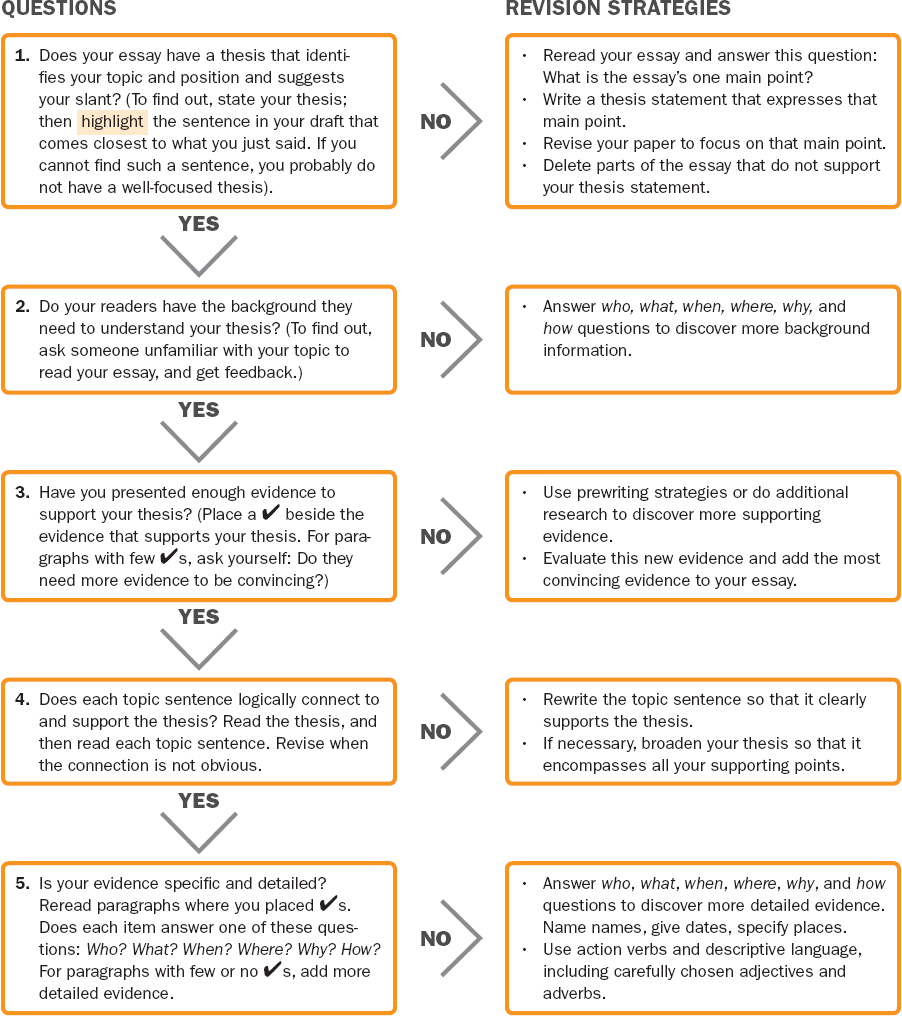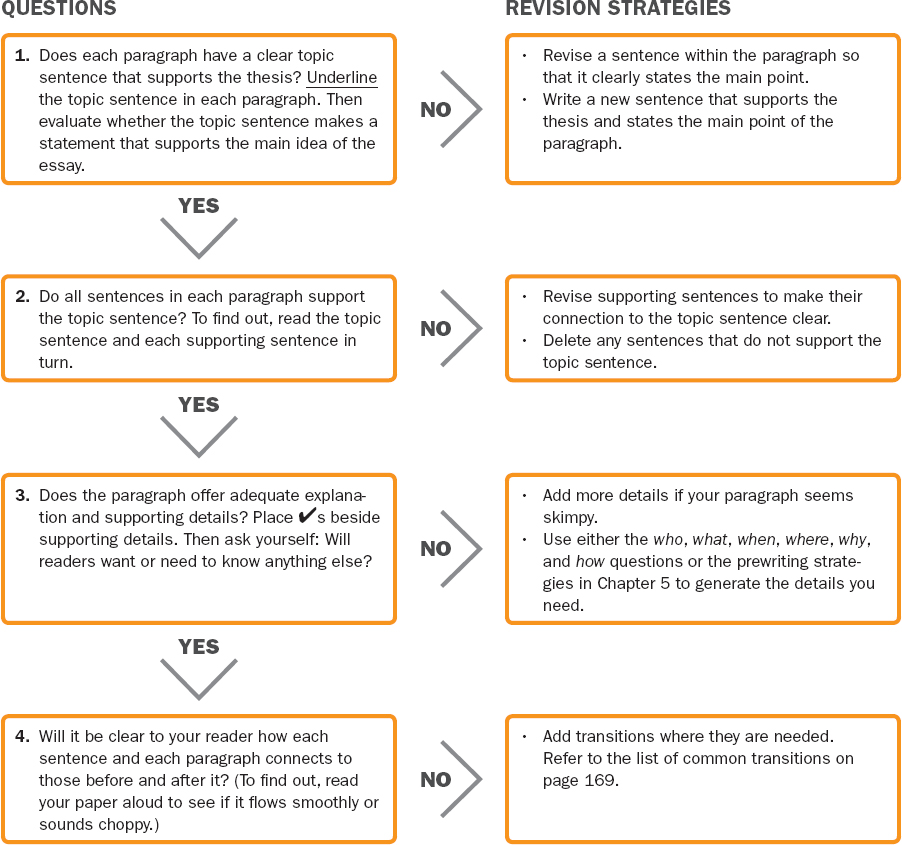KEY QUESTIONS FOR REVISION
To identify broad areas of weakness in your essay, ask yourself these five key questions.
- Does my essay clearly convey a purpose, address an appropriate audience, and follow the conventions of the genre?
- Does my essay state a clear, well-focused thesis and provide enough reasons and evidence to support the thesis?
- Does each paragraph include a clear main idea (usually stated in a topic sentence) and enough details to develop the idea fully?
- Do the ideas in my essay fit together logically?
- Does my essay have a strong introduction and conclusion, and an appropriate title?
After you have identified areas that need reworking, refer to the self-help flowcharts that follow.
ANALYZING YOUR PURPOSE AND AUDIENCE
First drafts often lack focus. They may go off in several directions rather than have a clear purpose. For instance, one section of an essay on divorce may inform readers of its causes, and another section may argue that it harms children. A first draft may also contain sections that appeal to different audiences. For instance, one section of an essay on counseling teenagers about drug abuse might seem to be written for parents; other sections might be more appropriate for teenagers. (For more about purpose and audience, see Chapter 5; for more about developing a thesis, see Chapter 6.)
To determine if your paper has a clear focus, write a sentence stating what your essay is supposed to accomplish. If you cannot write such a sentence, your paper probably lacks a clear purpose. To find a purpose, reread your draft. Does one purpose predominate? If so, revise the sections that do not fit in. If not, do some additional thinking or brainstorming, listing as many possible purposes as you can think of and revising to address the purpose you find most appropriate.
To determine if your essay is directed to a specific audience, write a few sentences describing your intended readers. Describe their knowledge, beliefs, and experience with your topic. If you are unable to do so, focus on a particular audience and revise your essay with them in mind.
Essay in Progress 1
Evaluate the purpose and audience of the draft essay you wrote in Essay in Progress 3 in Chapter 7 or another essay that you have written. Make notes on your graphic organizer or annotate your outline.
ANALYZING YOUR THESIS, TOPIC SENTENCES, AND EVIDENCE
Use Figure 9.3 to examine your thesis statement, topic sentences, and evidence.
Essay in Progress 2
Using Figure 9.3, evaluate the thesis statement, topic sentences, and evidence of the essay you began assessing in Essay in Progress 1. Make notes on your graphic organizer or annotate your outline.
ANALYZING YOUR ORGANIZATION
Your readers will not be able to follow your ideas if your essay is not unified. To assess your essay’s unity, examine its organization. Your graphic organizer or outline will help you discover any flaws.
You can also ask a classmate to read your essay and explain how it is organized. If your classmate cannot describe your essay’s organization, it probably needs further work. Use one of the methods in Chapter 7 or one of the patterns of development described in Chapters 12-21 to reorganize your ideas.

ANALYZING YOUR INTRODUCTION, CONCLUSION, AND TITLE
The following questions can help you evaluate your introduction, conclusion, and title.
- Will your introduction interest your reader and provide needed background information? If your essay jumps into the topic without preparing readers for it, your introduction needs to be revised. Ask the questions who, what, when, where, why, and how to determine the background information your readers will need. Then use the suggestions in Chapter 7 to create interest.
- Does your conclusion draw your essay to a satisfactory close, reinforce your thesis statement, and follow logically from the introduction? If not, try imagining yourself explaining the significance or importance of your essay to a friend, and use this explanation to rewrite your conclusion. Then use the suggestions for writing conclusions in Chapter 7 to add interest.
- Does your title accurately reflect the content of your essay? Write a few words that “label” your essay. Mine your thesis statement for a few key words that can serve as part of your title. Finally, use the suggestions in Chapter 7 to help you write a title.
Essay in Progress 3
Evaluate the organization of your essay in progress. Make notes on your draft copy.
ANALYZING YOUR PARAGRAPH DEVELOPMENT
Each paragraph in your essay must fully develop a single idea that supports your thesis. (Exception: Each paragraph of a narrative essay focuses on a separate part of the action; see Chapter 11.) In a typical first draft, paragraphs are often weak or loosely structured. They may contain irrelevant information or lack a clearly focused topic sentence. (See Chapter 8 for more on paragraph development.)
Study each paragraph in conjunction with your thesis statement. Consider whether your topic sentence supports your thesis and whether the reasons and evidence in the paragraph support the topic sentence. You may need to delete or combine some paragraphs, rework or reorganize others, or move paragraphs to more appropriate placement in the essay. If you need to supply additional information to support your thesis, you may need to add paragraphs to the draft. Use Figure 9.4 to analyze and revise your paragraphs.

Essay in Progress 4
Using Figure 9.4, examine each paragraph of your essay in progress, and make notes on your draft.